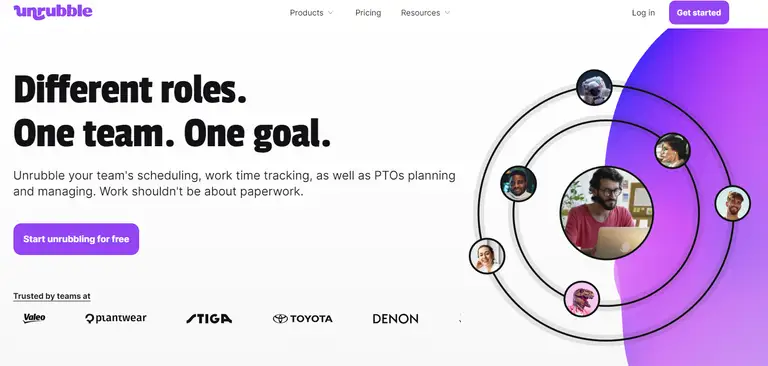It's amazing to be passionate about the work you do. Truly is.
But there's a fine line between passion and obsession, and crossing that line can lead to a condition known as workaholism.
Unlike a healthy dedication to one's career, workaholism is characterized by an excessive and uncontrollable need to work. It's not driven by the love of the job or the desire to achieve but by an underlying compulsion that can have serious personal and professional consequences.
What is workaholism, and how does it impact not only how an individual feels, but also how your team performs?
What is Workaholism?
Workaholism is a condition characterized by an excessive and compulsive need to work, often to the point where it interferes with other aspects of life. Unlike a healthy work ethic, workaholism is driven by an obsession with work that goes beyond normal commitments and can lead to physical and mental health issues.
Workaholic behaviors manifest in various ways, from consistently working long hours to an inability to disconnect from work-related tasks, even during personal time.
It's more than just putting in extra hours; it's a relentless pursuit of work at the expense of health, relationships, and overall well-being. We'll talk about it later on.

Signs of Workaholism in Your Team
These signs may be subtle at first, such as declining invitations for social activities in favor of work or feeling anxious when away from work-related responsibilities. Over time, however, these behaviors can become more pronounced and lead to the negative consequences previously outlined.
We've compiled a list of signs that your team might show. It's enough for one or two to show to let you know that you're dealing with a problem.
Extended Working Hours
Working around the clock? For people struggling with workaholism, it's not a one-off. It's an everyday reality. Team members consistently working beyond regular hours, including weekends and holidays, without a specific need. Or without a need that This can lead to burnout and negatively impact their overall well-being.
Obsession with Work-Related Tasks
Work. Work, work, work. Work. And work again.
An excessive focus on work-related tasks, even during personal time. Team members may talk about work constantly and prioritize it over family, hobbies, or other personal interests.
Decline in Personal Health and Relationships
A noticeable decline in personal health, both physical and mental, due to the constant stress and pressure of work. Relationships with family and friends may suffer as work takes precedence. And that's just a tip of the iceberg.
Inability to Disconnect
Team members may find it difficult to unplug from work, constantly checking emails and work-related messages during off-hours. This inability to switch off can lead to chronic stress. The result is, that switch-off simply stops existing, and is replaced by FOMO.
Resistance to Taking Time Off
A reluctance to take vacations, breaks, or sick days, even when needed. Team members may feel guilty or anxious about stepping away from work, fearing that they will fall behind or be perceived as less committed.
Decreased Productivity and Creativity
You can only be THAT creative and THAT productive for THAT long.
Ironically, workaholism can lead to lower efficiency over time. The constant pressure and lack of rest can hinder the ability to think creatively and perform efficiently. Being in a vicious circle of working more BECAUSE you are more productive is simply wrong and... counterproductive, also for life satisfaction.
Impact on Team Dynamics
Workaholism in one or more team members can create an unhealthy competitive environment and foster resentment among other team members. It may lead to unrealistic expectations and pressure on others to also overwork. Or, it might work other way around – people might feel they will never keep up and leave their work, looking for less stressful environments.
(Unspoken) Consequences of Workaholism
Workaholism is not only about signs or just some quick consequences – there are way more consequences to come and disrupt your company for years to come.
Physical Health Deterioration
Continuous overwork can lead to chronic fatigue, sleep disorders, headaches, and even more serious health problems like heart disease. The body's need for rest and recuperation is often ignored, leading to long-term health issues.
Mental Health Strain
The constant pressure and stress associated with workaholism can lead to anxiety, depression, and other mental health disorders. The inability to disconnect from work can create a continuous cycle of stress.
Family and Relationship Strain
Workaholism often leads to neglect of personal relationships, including family and close friends. It goes without saying that it can cause strain and breakdown in these relationships, leading to feelings of isolation and loneliness.
Decreased Job Satisfaction
Ironically, the obsession with work can lead to a decrease in job satisfaction over time. The lack of balance between work and personal life can create resentment towards the job and decrease overall happiness and fulfillment.
Impact on Team Morale
Workaholism in a team member can create unrealistic expectations and foster a toxic work environment. Other team members may feel pressured to keep up, leading to resentment, decreased morale, and potential burnout across the team.
Stifling of Creativity and Innovation
Constant work without breaks or time for reflection can stifle creativity and innovation. The mind needs time to rest and rejuvenate to think creatively, and workaholism hampers this process.
Legal and Ethical Implications
In some cases, workaholism can lead to legal and ethical issues. For example, if an employer is encouraging or demanding excessive work hours without proper compensation or breaks, it may lead to legal challenges.
Potential Career Stagnation
While workaholism may initially seem like a path to career advancement, it can eventually lead to stagnation. The lack of balance and the potential decline in health and creativity can hinder long-term career growth.
Loss of Personal Identity
A person's identity may become so intertwined with their work that they lose sight of who they are outside of their job. This loss of personal identity can lead to existential crises and a lack of fulfillment in other areas of life.
Environmental Impact
The extended working hours and constant use of electronic devices can have an environmental impact as well, contributing to increased energy consumption.
Now that you know how serious this is, let's hop on how to deal with it.

How to Get Rid of Workaholism in Your Work Environment
Below, you'll find a few good practices for combating workaholism in your workplace.
Set Clear Boundaries
Encourage employees to set clear work-life boundaries. This includes defining work hours and ensuring that personal time is respected. Management should lead by example and adhere to these boundaries as well.
Promote a Healthy Work Culture
Foster a work culture that values balance and well-being. Encourage regular breaks, time off, and activities that promote relaxation and creativity. Recognize and reward quality work rather than just long hours.
Provide Support and Resources
Offer support to employees who may be struggling with workaholism. This could include access to counseling services, workshops on time management, or creating a supportive peer network within the organization.
Encourage Regular Time Off
Make sure employees are taking their entitled vacation time, sick days, and personal days. Encourage them to fully disconnect during this time and assure them that it's not only acceptable but necessary for their well-being.
Implement Flexible Work Schedules
If possible, offer flexible work schedules that allow employees to balance work with other life commitments. This can reduce the pressure to be constantly "on" and allow for a more personalized approach to work.
Monitor Workloads
Regularly assess workloads to ensure they are manageable and realistic. If an employee is consistently working overtime, it may be a sign that their workload is too heavy and needs to be adjusted.
Provide Opportunities for Growth
Sometimes, workaholism stems from a fear of stagnation or lack of progress. Providing clear paths for career growth and development can alleviate this fear and reduce the compulsion to overwork.
Communicate Openly
Encourage open communication about work expectations, concerns, and feelings related to work-life balance. Creating a safe space for these conversations can help identify issues early and foster a supportive environment.
Lead by Example
Managers and leaders should model the behavior they want to see in their teams. If leadership is consistently working long hours and neglecting personal life, it sends a message that this behavior is expected and rewarded.
How Unrubble Can Help You Combat Workaholism in Your Workspace
Time Tracking: A Measure of Workaholism
Unrubble's time tracking feature allows you to monitor the hours your employees are putting in, providing valuable insights into workaholic tendencies. By tracking overtime and reconciling discrepancies in work time, you can identify employees who may be at risk of emotional exhaustion due to excessive work behaviors.
Scheduling: Balancing Work and Private Life
The scheduling feature in Unrubble ensures that there's no communication jamming and helps maintain a healthy work-life balance. By using powerful wizards, schemas, and real-time notifications, you can schedule breaks and off-days effectively, combating the prevalence of workaholism in your workspace. No more definition of workaholism in your company.
PTO Tracker: Managing Emotional Discharge
Paid Time Off (PTO) is crucial for employee well-being. Unrubble's PTO Tracker simplifies the request management system for absences, work from home, and business trips. This feature can be a significant step in addressing the negative spillover effects of workaholism on an employee's psychological health.
Timesheets in Real-Time: Monitoring Workaholic Culture
Real-time timesheets allow you to avoid table-hopping and spreadsheet-wrangling, giving you an accurate picture of how much time employees are dedicating to their tasks. In 21st century, this can be a useful tool in identifying workaholic culture and taking steps for its conceptual integration into a healthier work environment.
Mobile Time Clock with Face Recognition: Ensuring Healthy Work Investment
The mobile time clock feature with face recognition ensures that employees are not clocking in extra hours unnoticed. This level of precision can be crucial in identifying workaholic tendencies and ensuring that employees are not investing an unhealthy amount of time in work.
Employee Self-Service App: Empowering Employees to Monitor Their Own Behavior
The free employee self-service app keeps your team notified in real-time, allowing them to keep up with schedules and work requests easily. This single factor can help in empowering employees to monitor their schedules, and it can be an effective way to make them aware of their workaholic tendencies, thereby encouraging self-regulation.

Types of Workaholics in Your Team
Non-Enthusiastic Workaholics: The Heavy Work Investment Trap
Non-enthusiastic workaholics are individuals who invest a heavy amount of time and resources into their jobs but derive little to no joy from it. This type of workaholism condition often leads to emotional exhaustion and a decline in quality of life. Understanding the relationship between workaholism and these behavioral tendencies is crucial for effective management.
The Addictive Workaholic: Scaling the Addiction Scale
This type of workaholic exhibits addictive behaviors similar to drug addictions. They are often so engrossed in their work that they neglect other aspects of life. Utilizing an addiction scale can help in identifying the severity of their condition and taking appropriate measures.
The Overachiever: Internal Consistency and Behavioral Tendencies
These workaholics are characterized by a strong internal consistency in their work ethics. They are driven by the need to achieve and often set high standards for themselves. However, this can lead to a skewed work-life balance and needs to be managed carefully.
The Global Workaholic: Country × Workaholism
Interestingly, workaholism is not just confined to the United States but is a global phenomenon. The relationship between workaholism and culture, especially in individualistic cultures, can offer additional factors that contribute to this condition.
The Data-Driven Workaholic: Correlation and Regression Analysis
Some workaholics are motivated by metrics, natural resources, and job resources. They often rely on correlation analysis and regression analysis to measure their performance, which can sometimes exacerbate their workaholic tendencies. The relation between workaholism and data is very visible here.
The Academic Workaholic: Influences of Andreassen, Griffiths, Hetland, and Others
This type of workaholic is often influenced by academic literature and theories. Names like Andreassen, Griffiths, and Hetland are frequently cited, and their work serves as a basis for these workaholics to justify their excessive work behaviors and term workaholism as a whole.
Understanding these types can help managers and HR professionals tailor their approach to managing workaholism in the team, ensuring a healthier work environment for all.
Conclusion
Understanding workaholism and recognizing its manifestations are essential for both individuals and organizations. It allows for early intervention and support to maintain a healthy work-life balance and prevent the far-reaching impacts of this condition. Whether you're an employer, a colleague, or someone who finds themselves struggling with workaholism, awareness is the first step towards a more balanced and fulfilling professional life.








